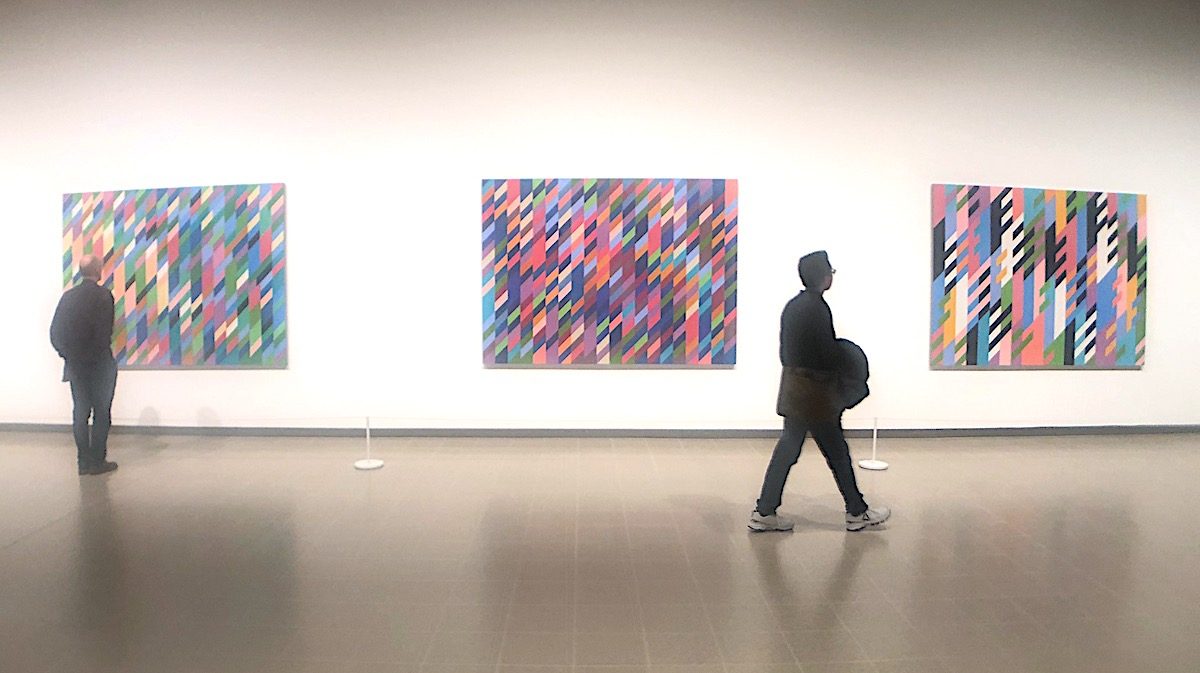At a time when there is a continual fuss about giving ‘fair representation’ to women artists, many of whom were not, in fact, central to the major art movements to which they, often peripherally, belonged, the Bridget Riley show at the Hayward comes as a major relief. Here is a woman artist who has had a meaningful career, and who is without a doubt central to the story of visual art in her time.
No pleas for special consideration need to be made. She arrived in the art world at the right time and made the most of it – ELS
Op Art, as much as Pop, counts as a major moment in the progress of contemporary art, and Riley is one of its most important – perhaps indeed the most productive and influential representative of this particular style. Her new retrospective at the Hayward Gallery here in London makes it very clear why this has been the case.

Op is an abstract style. It essentially belongs to the moment when pure abstraction was challenged by Pop, at which time a certain number of artists decided that a purely abstract art did, in fact, have a future, not merely a past.
As Riley’s Hayward retrospective demonstrates, she began her career as a fully equipped figurative artist. She was a much more fluent figurative draughtsman than almost any of her contemporaries. As a painter, her first major exemplar was Seurat, and her early figurative paintings in Seurat’s manner run their exemplar pretty close, in terms of quality.
What Op Art had to offer her was a way not only of moving towards the future but also of becoming that future. Going in such a direction was a deliberate choice. It was a mark of this that, to begin with, Riley abandoned colour. Her early Op works were in black and white. This also, I think, was a sign of her interest in rational experimentation. I mean ‘rational’ as opposed to ‘impulsive’. Pure abstraction had reached an impasse, Riley wanted to see what else it could be made to do. The answer was to think, not only about the actual composition but about the way in which the human eye reacted to patterns on a surface. To the dynamic interactions, these patterns could set up within the spectator’s own physiology of sight.
Essentially this is the journey Riley has been on ever since – gradually introducing colour, seeing how those chosen colours could be made to interact. The Hayward exhibition is very good at presenting this sequence of possibilities, and also at showing how Riley reacted to the various discoveries she made in interrogating them. There are no dead ends in this show.
What Riley discovered was a way of presenting and making physical, what are essentially immaterial reactions. Her studio practice reflects this. The paintings, in their final form, are made not by the artist herself, but by assistants whom she oversees. The experimentation, the thinking, behind what eventually appears on a chosen surface, are, on the other hand, entirely her own. The painted surfaces, however, are not soulless. They are still, subtly, things that are created, not by machines, but by human hands.
In some very recent works, Riley has abandoned the idea of painting-on-canvas altogether. The painted designs are made directly on the walls of the gallery. When the exhibition is over, they will no longer exist. In this sense, the exhibition I in step with the tendency, among official galleries, in particular, to make exhibitions who legacy is only in the minds and the visual memories, of those who attend them.
Riley has, on the other hand, being an extremely important printmaker, since her designs, with their even colours and clean edges, are easy to translate into media other than paint. Op Art has, in this sense, proved to be a down-to-earth art form. Pop borrows from popular culture, Op contributes directly to it. In fact, one of the significant features of Riley’s work is that it is genuinely democratic. You don’t need specialised knowledge to react to it. Your eyes will do that for you.
Bridget Riley – Hayward Gallery – 23 OCT 2019 – 26 JAN 2020

